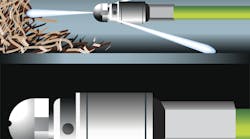Latest from Management
Sponsored
Professional drain cleaning is an art unto itself. Our firm evolved slowly to adopt motorized drain cleaning equipment. Prior to that, we primarily utilized metal ribbon push tapes and hand-cranked auger cables to clear blockages and tree roots. You definitely got a physical workout!
When the Behlers bought their first Ridgid K50 and K1500 sectional cable powered drain-cleaning machines that enabled us to do the work in less time and provide a more thorough job. Eventually, a Ridgid K45 and K400 joined the battle, as did a second and third K1500.
After subcontracting several video inspections to competitors, we located a site for several manufacturers to provide live demonstrations and included their tracking locators so that we could decide which one was going to be purchased. Given the hefty investment, it was important to have a live hands-on test-run. That led to the purchase of our Ridgid Sea Snake constant-level color image drain-line camera, with recorder, as well as the NaviTrack locator that can pinpoint the video camera’s location and depth. In addition, we purchased the line transmitter to induce a signal into metal (wires, etc) for locating or follow live energized wiring. A Sea Snake Micro Drain video inspection camera followed its big brother and has been used for not only drains two inches and smaller, but proven to be a great inspection tool outside of drain lines — like checking furnace heat exchangers. This equipment has paid for itself many times over. Read on to see why this just saved us from a real nightmare!
Our first water jetter, a Ridgid K1750, was brought on board a few years later and proved to be great for residential applications. A few months ago, a very large apartment complex with miles of underground sanitary sewer lines requested a quote to water-jet the building drains, the lines from each building to the mains, and the mains from manhole-to-manhole to where they connect with the township’s municipal sewer main. 4-in., 6-in., 8-in. and 10-in. lines with known issues of grease, paper towels, wipes and feminine hygiene products previously retrieved with the K1500.
Just as I had waited for a sufficiently large job before purchasing our Ridgid ProPress tool (a Cheeseburgers in Paradise restaurant), this presented an opportunity to up our game by adding the KJ3100 water jetter. Given the substantial investment, the bid was first and once accepted it was time to obtain quotes from our suppliers. As I sat down to start the search, an email from Maryland Pipe & Supply appeared with a special package offer on the KJ3100. The order was placed!
Although familiar with using the K1750, the 3,000-PSI generated by the KJ3100 command respect for the dangers present. Thanks and a hat-tip to Cory Caron with Emerson for the live on-site training session. The following day, we hit the road with the KJ3100 and started with the apartment complex mains to clear a path for the debris we knew we would blast free in the dozens of branch lines. We had upgraded from the standard kit’s 200-ft. hose and opted for a 300-ft. hose due to the distance between manholes being just under 300-ft. and the distance from buildings to mains approaching 300-ft. in several cases. The work progressed faster than I had anticipated — until the last drain on the last day.
“We can’t get the hose back. There’s 200 feet stuck in the line! If we pull any harder, the hose will no doubt tear. It won’t go forward or backward, not even in pulse mode.”
Our first water jetter was brought on board and proved to be great for applications.
Fortunately, the standard size Sea Snake could be employed and offered a view of the cable as we pushed the camera down the line. Before long, a larger void opened up and we could see the tangled mass of spaghetti that was the jetter hose. While it appeared logical for the drain line to be headed towards one manhole, the NaviTrack did not agree, so we pulled the camera back to the cleanout riser and began following the camera as it was being pushed down the drain line. Off on a 90-degree angle from where logic would dictate, but there was no doubt we were pinpointing the camera’s location. When we hit the tangled spaghetti-like mass of jetter hose, we were at 10.5-ft. deep. Thinking the void space we were seeing could possibly be a manhole; we probed the area with a digging bar, but found no signs of anything solid or a metal lid.
By now you might be thinking: Hey dummy, check the as-built drawings! Been there, did that more than a year ago and the site utility plans were long ago lost. All we had to go on were the existing manholes and cleanouts the maintenance crew knew existed. I marked up a site plan to create a more permanent record and now that we were just about finished jetting the lines, video inspections of the entire drainage system were next on the list, which would allow us to fill in the blanks regarding where they are located below grade.
A call was made to have the utilities marked because, wouldn’t you know it, telephone, TV cable, and power service lines to several buildings run down the telephone pole and disappear just feet away from where we needed to dig! Verizon was on strike, so no chance they’d be out to mark for us. We brought in our trusted excavation subcontractor, and, after excavating more than 3-ft. through a mass of tree roots (did I fail to mention a tree was immediately adjacent?), he hit something solid. It was a manhole that no one knew existed and buried more than 3-ft. deep to the top of its lid.
The good news was being able to retrieve the 300-ft. jetter hose unharmed. A 3-ft. riser ring was installed on the manhole to bring its lid up to grade and jetting of this last drain was completed.
Video inspections revealed several things: the KJ3100 did a thorough job of restoring the drains to their original as-new cleanliness; flushables were already being sent down the lines; non-flushable paper towels too, and several bundles of tree roots were occasionally located. The KJ3100 kit comes with a Root Ranger nozzle designed to shear off roots. It sounds like an angry swarm of bees while in use and the follow up video check revealed the roots had been obliterated.
Add one extra feature: locates long lost manholes! This is one more professional tool that will pay for itself many times over.
All Dave Yates material in print and on Contractor's Website is protected by Copyright 2015. Any reuse of this material (print or electronic) must first have the expressed written permission of Dave Yates and Contractor magazine. Please contact via e-mail at: [email protected].
Dave Yates
Dave Yates material in print and on Contractor’s Website is protected by Copyright 2017. Any reuse of this material (print or electronic) must first have the expressed written permission of Dave Yates and Contractor magazine.


